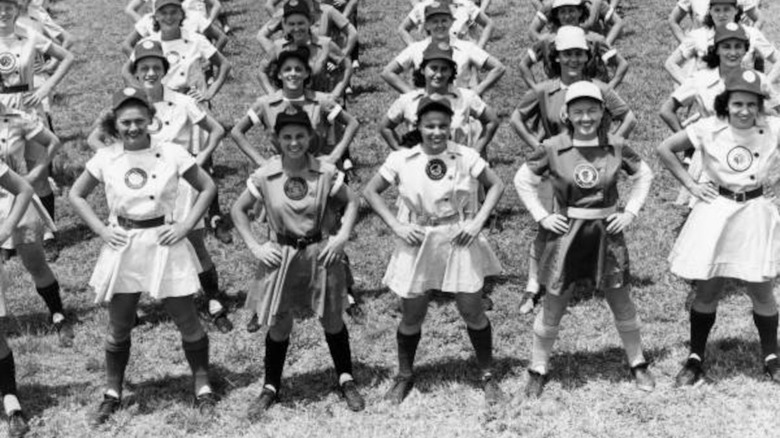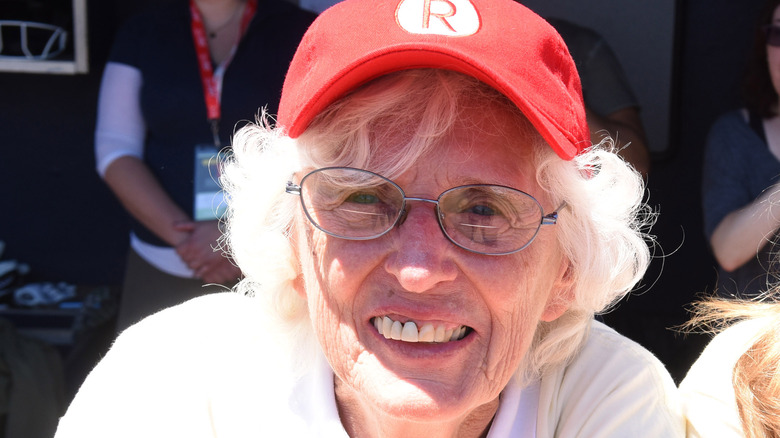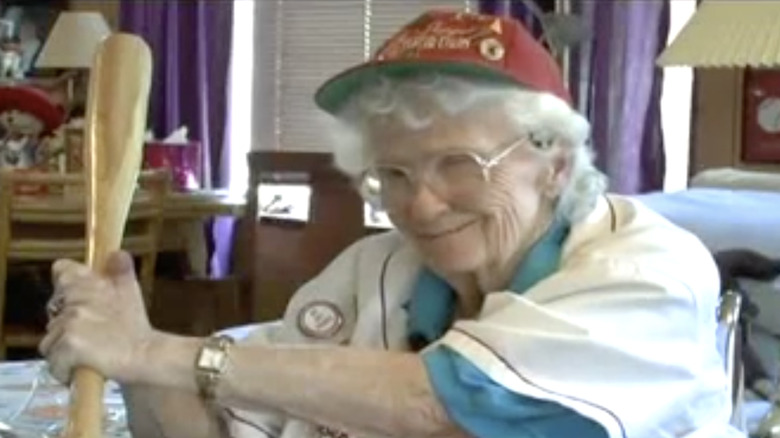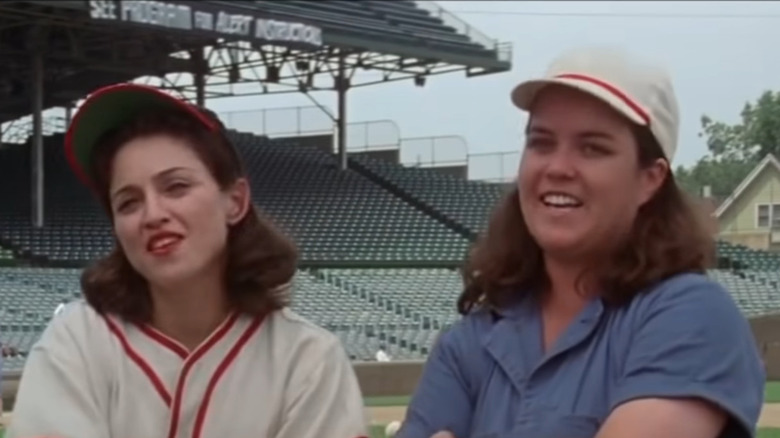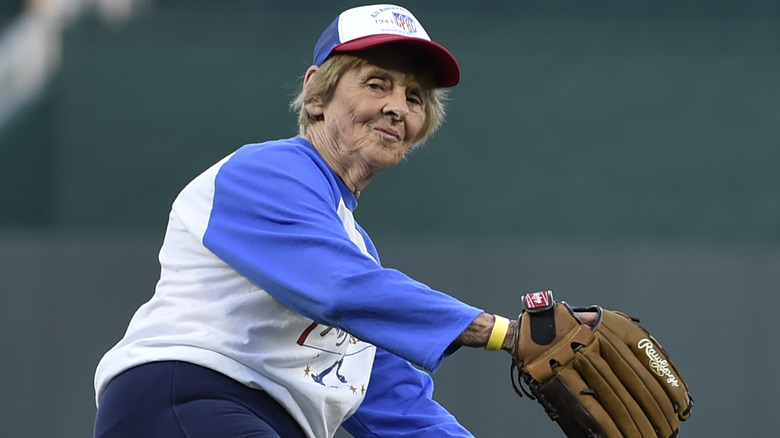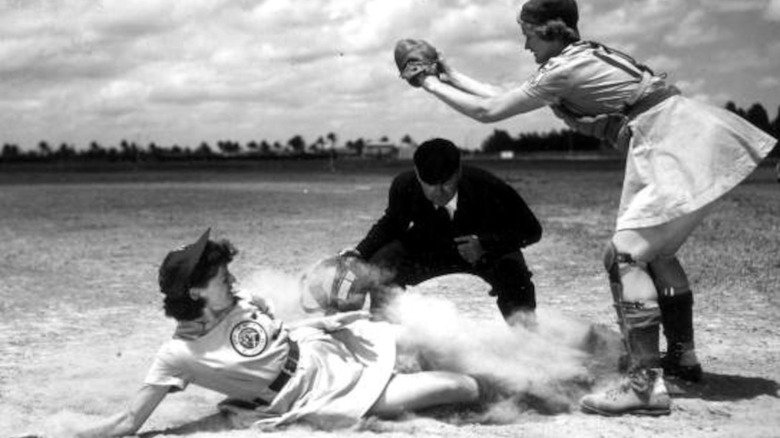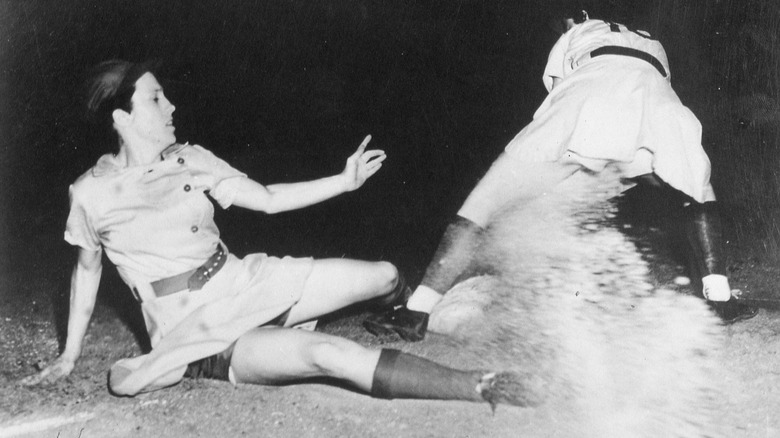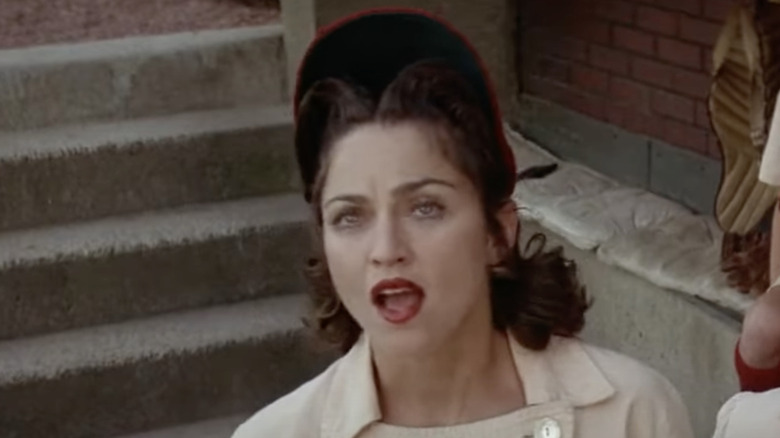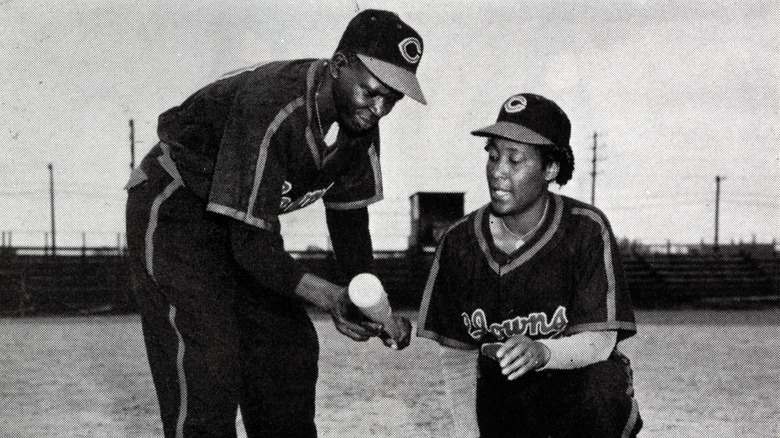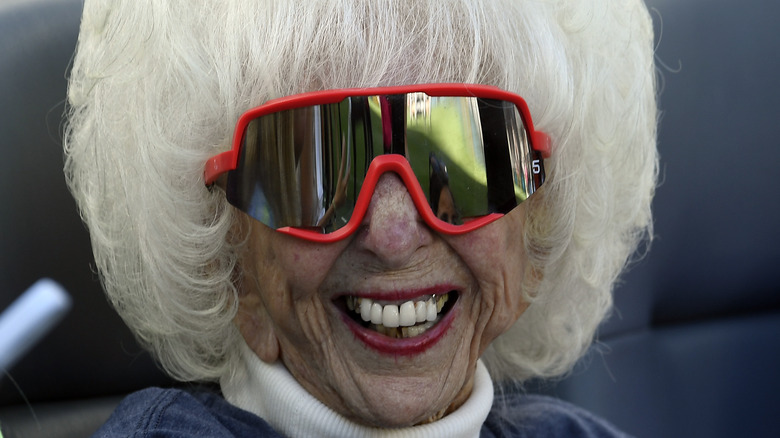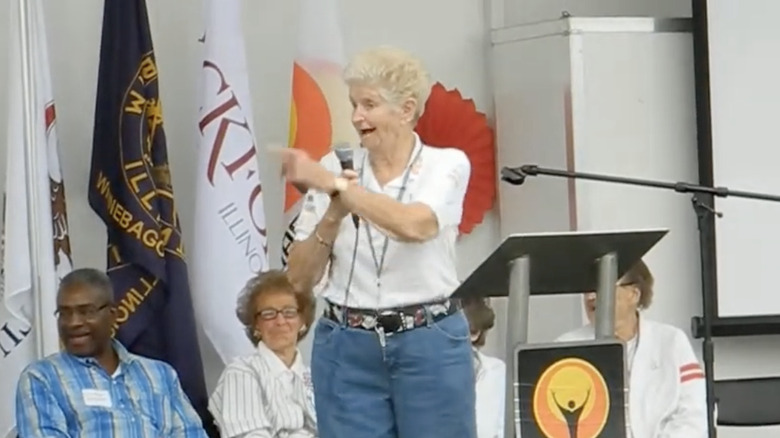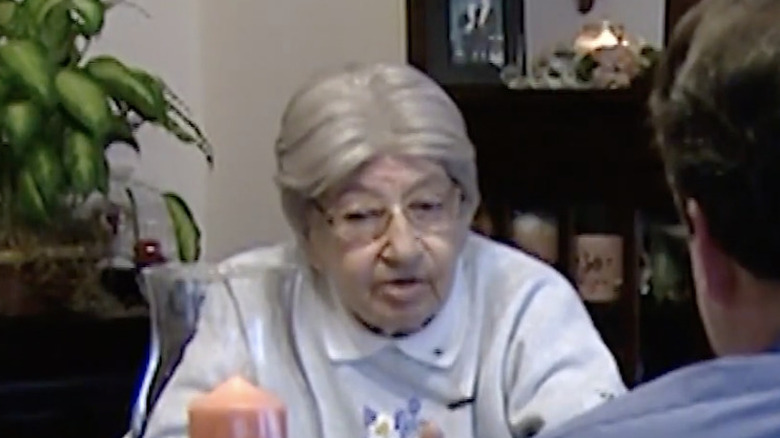The Real Women Who Inspired A League Of Their Own
Baseball is called "America's pastime," so it isn't too shocking that the sport mirrors the mood and personality of the country. America hasn't always been the most tolerant and progressive place on Earth, so it shouldn't surprise you that baseball has reflected the country's intolerance, refusing to let Black athletes play in the major leagues for the first five decades of its existence (via PBS). But at least that changed in 1947 when Jackie Robinson took the field, shattering the race barrier at great personal risk. Another barrier has never been broken — a woman has never played major league baseball.
That doesn't mean there aren't extremely talented female baseball players — or that a woman has never played professional baseball. As the documentary, film, and now TV series "A League of Their Own" explores, the All-American Girls Professional Baseball League (AAGPBL) existed from 1943 to 1954, fielding 15 teams, employing nearly 600 athletes, and drawing in more than a million fans in a single season with its high quality of play.
While the franchise tells an important — and highly entertaining — story, many of the characters we love are fictitious, albeit based on the real women who hit the diamond during World War II and beyond. The most incredible fact about "A League of Their Own" is how much of the stuff on the screen actually happened — and how incredible the true stories behind the fiction actually were. Here are the real women who inspired "A League of Their Own."
Shirley 'Hustle' Burkovich: For love of the game
Growing up in Swissvale, Pennsylvania, Shirley Burkovich ran into familiar barriers when pursuing the sport she came to love as a kid. Sports Engine reports that Burkovich learned to hit by playing by herself in her backyard or in vacant lots nearby. When she got into high school, she tried to play ball with her brothers and their friends, but the most they would let her do was catch a few fly balls as they practiced. There were pretty much zero opportunities for girls to play baseball in any organized way.
MLB.com notes that Burkovich's brother urged her to join the AAGPBL in 1948, so she tried out and was soon playing professionally for the Muskegon Lassies at the ripe age of 16. She played for several teams, including the Rockford Peaches, before retiring from the game in 1951. Her intense style of play earned her the nickname "Hustle." She went on to co-found the International Women's Baseball Center (IWBC).
Burkovich was considered such a force in women's baseball that she actually made a cameo in the film "A League of Their Own," according to Sports Engine. She appears at the end as the older Alice "Skeeter" Gaspers, telling Dottie Hinson at the reunion, "Dottie, having you here is good luck." She remained a fierce proponent of baseball and women's role in it, organizing clinics and working to develop female athletes her entire life.
Lavonne 'Pepper' Paire-Davis: Consulted on the film
Lavonne "Pepper" Paire-Davis is frequently cited as one of the main inspirations for the characters in "A League of Their Own." According to People, Paire-Davis played 10 seasons for the AAGPBL from 1944 until 1953. Paire-Davis was a big inspiration for the role played by Geena Davis in the film, star catcher Dottie Hinson. Per The New York Times, Paire-Davis was 19 and working as a shipyard welder when a friend suggested she try out for a team with the AAGPBL. She was soon playing catcher and shortstop under the name Pepper Paire for the Minneapolis Millerettes. According to The New York Times, Paire-Davis was a star fielder with a fielding percentage of .977 and drove in 400 runs.
Davis was a personality, boasting of having boyfriends in every city the league visited and co-writing the league's unofficial theme song, "Victory Song," which is still sung at AAGPBL reunions. You can hear that song in the film "A League of Their Own," which consulted Paire-Davis.
According to The New York Times, Paire-Davis was driven by a pure love of the game, learning how to play from her brothers. Per AP News via USA Today, she once said, "Baseball was the thing I had the most fun doing. It was like breathing." She never lost her love of baseball, watching games frequently and teaching her children and grandchildren how to play the game.
Dolores 'Pickles' Lee-Dries: Breaker of barriers
Born in 1935 in Jersey City, New Jersey, Dolores Lee-Dries was always athletic. According to NJSports.com, she played baseball and basketball with her brothers and other neighborhood kids as a child and played in a summer softball league when she was a teenager. The Rockford Register Star reports that Lee-Dries always dreamed of playing baseball professionally — from the age of nine, she knew that was what she wanted out of life.
Lee-Dries played three seasons with the Rockford Peaches from 1952 until the AAGPBL shut down in 1954. She loved playing so much that she immediately joined up with 15 other women to play exhibition games around the country, per the Rockford Register Star. At one point while playing a game, famed Major League Baseball player Eddie Stanky came out of the dugout to shake her hand and tell her he wished she was a man. Lee-Dries also perfected a trick she liked to show off for the crowd, pitching two baseballs at a time. The trick also made its way into the film "A League of Their Own," where Rosie O'Donnell performed it (via NJSports.com).
Lee-Dries played baseball professionally until 1958 when she quit the game to break ground elsewhere by becoming the first full-time woman police officer in Jersey City. As noted by author Arthur W. Pease in his book "Historical Highlights: Jersey City Police Department," Lee-Dries completed the same course as the men in her academy class — often outperforming them.
Jeneane 'Lefty' Lesko: Bat girl turned pro
Jeaneane Lesko was working as a bat girl for a local baseball team when she learned that the AAGPBL was still playing games. According to ABC News, she drove to the tryouts and was initially shocked at the girls' short uniforms. She was selected by the Grand Rapids Chicks and played two seasons with them in 1953 and 1954.
Lesko, who consulted on the film "A League of Their Own" to help the actors and writers get the details right, told ABC News that the opportunity was about more than equality or even the love of baseball — for many players, it was about money. She pointed out that players could make as much as $150 a week, often more than twice what their parents were making working in factory jobs. They became a lifeline for their families.
That doesn't mean they didn't have fun, too. ABC News notes that the pranks and humor on display in the film and series were very true to life — and the chaperones were definitely targeted. Lesko confesses that the players often put salt in their beds and once placed a freshly-caught fish in a chaperone's bathtub.
Lesko remained involved with the game after the league dissolved. The AAGPBL reports that she founded the Washington Women's Baseball Association in 2003, became editor of the AAGPBL's newsletter in 2001, and served on the AAGPBL Board of Directors from 2002 to 2010.
Terry Donahue: A Secret love
If the name Terry Donahue is familiar to you outside of baseball history, it might be due to the 2020 Netflix documentary, "A Secret Love." The film documents the 71-year love affair between Donahue and Pat Henschel — an affair the women felt they had to keep secret. The Advocate reports that Henschel and Donahue met in 1947 while Donahue was playing baseball professionally. As reported by CBC News, coming out as gay in the 1940s was a dangerous prospect. The women told their families they were just friends seeking to split the rent. The couple finally married in 2015, per The Advocate.
Donahue was also a star baseball player for the AAGPBL, where she played from 1946 to 1949 for the Peoria Redwings. She holds an amazing record, driving in a remarkable 32 runs on 31 hits in the 1948 season.
According to WBEZ Chicago, Donahue confirmed something the film "A League of Their Own" depicted: how difficult it was to play baseball in a skirt. Donahue says the girls would often wear jeans on the buses but were expected to always appear in public — and play — in skirts. The "one-piece skirt we had with 6 inches above our knees was really not very good for our knees for sliding," she told WBEZ Chicago, stressing that they might have dressed like ladies, but they played "like men."
Helen and Margaret Callaghan: Inspiring sisters
The entire "A League of Their Own" franchise owes a debt to Helen Candaele and Margaret Maxwell. As noted by MLB.com, Kelly Candaele — son of Helen — got the idea to make a documentary about his mother and his aunt in 1987. The documentary was called "A League of Their Own," and its success led to Kelly pitching story ideas to Penny Marshall at the director's birthday party — along with Robert De Niro, Bruce Willis, and other Hollywood celebrities. The story he eventually pitched involved two sisters with a growing rivalry playing in the AAGPBL.
The story eventually fictionalized the real-life Helen and Margaret into Dottie and Kit Hinson (played by Geena Davis and Lori Petty). As noted by The Washington Post, the character of Dottie was an amalgamation of several players, most notably Dorothy Kamenshek. But the basic premise of two sisters playing in an all-women league — Helen played for the Minneapolis Millerettes, Fort Wayne Daisies, and the Kenosha Comets, and Margaret played for the Millerettes, Daisies, South Bend Blue Sox, the Peoria Redwings, and the Battle Creek Belles — came directly from the Candaele siblings.
According to CBC News, Helen and Margaret grew up playing baseball and playing softball for local teams. They were scouted in 1943, and both were superstar players. Helen held the all-time record for stolen bases, stealing a remarkable 114 bases in 112 games in 1946.
Dorothy 'Dottie' Kamenshek: The real Dottie
The character of Dottie Hinson (played by Geena Davis in the film "A League of Their Own") isn't based on a single character. But since she's presented as one of the best players in the AAGPBL — and she's named Dottie — it makes it obvious that one of the biggest inspirations for the character was Dorothy "Dottie" Kamenshek. According to The Washington Post, Kamenshek was "often considered the finest female baseball player ever."
Kamenshek's career in the AAGPBL is pretty legendary and includes two batting titles (she also owns the best lifetime batting average in league history with a .292 mark) and seven All-Star selections, according to Britannica. Ms. Magazine reports that Hall of Famer Wally Pipp believed she would be the first woman to play on a Major League Baseball team, and she was recruited to play for an all-male team. (The New York Times reports she turned them down, saying she thought it was just a publicity stunt and that she doubted she could go up against the much larger male players.)
Kamenshek played professionally for 10 years. Britannica notes that she retired in 1951 after back injuries took their toll, but she was so popular she returned to the Rockford Peaches for the 1953 season to help bring more fans to the stands. She batted .293 that year but retired again at the end of the season. She passed away in 2010 at the age of 84, per The New York Times.
'All the Way' Faye Dancer: Madonna's inspiration
The AAGPBL was a serious sports league, but it had its share of wild personalities. One of the biggest was Faye Dancer, known as "All the Way Faye." According to The Washington Post, Dancer was the inspiration for the character portrayed by Madonna in "A League of Their Own," known as "All the Way Mae."
Dancer wasn't just a talented player (setting a single-season record with 108 stolen bases), she also brought a sense of fun and showmanship to the games. The New York Times reports that Dancer often cavorted about doing handstands and lifting her skirt when fans became bored during slow stretches.
Dancer was a natural athlete. In high school, she played for an all-girls softball team sponsored by Dr. Pepper. Born in California in 1925, she was scouted for the AAGPBL in 1944 and played for seven years on three teams: the Minneapolis Millerettes, the Fort Wayne Daisies, and the Peoria Redwings. According to The New York Times, she's considered such an iconic player that her spikes and gloves are on display at the Baseball Hall of Fame in Cooperstown, New York. As noted by History vs. Hollywood, Dancer played hard and was also an inspiration for the famous "strawberry" injury suffered by a player sliding into a base in a short skirt. Per The Washington Post, she once said she loved to slide and admitted, "we did take the hide off ourselves."
Toni Stone, Mamie Johnson, and Connie Morgan: The forgotten women
For 1992, "A League of Their Own" is pretty progressive as a movie that at least takes women seriously as both athletes and human beings. But it was also pretty white and straight in its worldview.
The film makes only a cursory nod towards the role of talented Black women, including a famous scene where an unnamed Black woman retrieves an errant ball and fires a fastball back, demonstrating serious chops. It's a clear nod towards the women athletes of color who didn't even get to play in a second-class pro league. The scene is partially inspired by three remarkable women — Toni Stone, Mamie Johnson, and Connie Morgan. As noted by the Baseball Hall of Fame, these three women played for the all-male Negro American League in the 1950s.
Rolling Stone reports that when the new "A League of Their Own" series was conceived, the character of Maxine Chapman was developed to represent Black female trailblazers in the sport like Stone, Johnson, and Morgan. As noted by Yahoo! Sports, the series doesn't sugarcoat reality — Max can't get a tryout with the AAGPBL due to her skin color and has to resort to taking a factory job in order to find her way in.
Maybelle Blair: Telling her truth
The original "A League of Their Own" film ignored one important aspect of the impact of the AAGPBL — its impact on the LGBTQ+ community. According to The Hollywood Reporter, one of the consultants on the TV series based on the AAGPBL is Maybelle Blair, who played one season with the Peoria Redwings in 1948. Blair, who is 95, said working on the new show had inspired her to come out as a lesbian for the first time in her life.
The Los Angeles Times reports that leg injuries limited Blair's active playing time, but she has been a fierce advocate for women in sports her entire life. Blair has worked for years with Baseball For All, a nonprofit that works to give girls the opportunity to play the sport. Blair kept her own sexuality under wraps for decades for fear of both professional and personal backlash but is helping the new series focus on the secret queer relationships enjoyed by many of the players during the AAGPBL's heyday in the 1940s and 1950s. According to Bustle, Belle told the showrunners that the atmosphere for LGBTQ+ players in the league has been described as "a party" during a time when it was dangerous to admit to being queer.
One thing Belle has made clear: After decades of hiding, she intends to ensure the LGBTQ+ story of women's baseball is finally told.
Helen 'Sis' Waddell Wyatt: Toughing it out
In an interview with the Chicago Baseball Museum, Helen Waddell said that growing up in Lemoyne, Pennsylvania with five brothers who called her "Sis" toughened her up: "Whatever there was to be done, I was out there with them. I was a tomboy, but I had to be to defend myself."
Her brothers taught her well. As reported by the Rockford Register Star, Waddell was scouted by the AAGPBL in 1950 and was invited to try out in Allentown, Pennsylvania. She was soon part of the Rockford Peaches, got traded to the Battle Creek Belles, and then returned to the Peaches to close out the 1951 season. Waddell left the league — and pro baseball altogether — after the 1951 season to get married. Her new husband asked her to stop playing, and at that time "girls did what their husbands wanted," she said. Later in life, she wished she'd kept playing.
Waddell was legendary for her toughness. When she slid head-first during a game, her manager Bill Allington got angry and took her to a sliding pit, where Waddell "ran and slid and ran and slid" until she'd mastered the proper technique. And when a male spectator wouldn't stop heckling the women, she and her teammates began aiming foul balls directly at him, forcing him to eventually hide behind a light pole, per the Rockford Register Star.
Dottie Ferguson Key: Love the game
Dottie Ferguson Key played 10 seasons in the AAGPBL, all but part of one with the Rockford Peaches made famous in "A League of Their Own." It's safe the say the film wouldn't exist — or would be very different — without her legacy. According to the Los Angeles Times, she was a partial inspiration for the character played by Madonna in the film, "All the Way" Mae Morbadito.
Key was one of the AAGPBL's biggest stars, winning four championships with the Peaches in 1945, 1948, 1949, and 1950. Her love of the game ran deep — The Seattle Times reports she was famously quoted as saying "I'd rather play ball than eat or sleep." Key was fast and stole a lot of bases — 91 in 1951 alone — which isn't surprising, considering she was the North American women's speed skating champion in 1939 and missed her chance at the Olympics because of World War II. She married in 1949 — but made it clear to her new husband that she would continue to play baseball.
Key has secured a spot as one of baseball's biggest legends: She's a member of the Canadian Baseball Hall of Fame, and her road uniform is on display at the Baseball Hall of Fame in Cooperstown, New York. And in 1987, Key was a big part of the documentary "A League of Their Own," which inspired the theatrical film directed by Penny Marshall.
